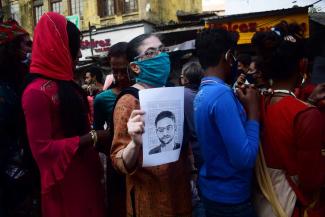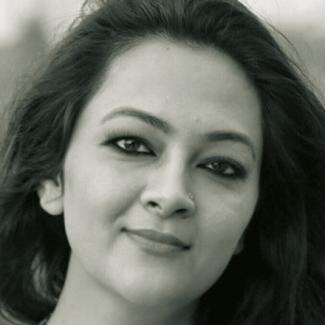Totalitarian aspirations
Modi opponents are called anti-national
 picture alliance / Pacific Press / Santarpan Roy
picture alliance / Pacific Press / Santarpan Roy
In December, leading Hindu supremacists met for a three-day conclave in the north Indian town of Hardiwar. One demand raised was that Muslims in India should be treated the way Myanmar’s Muslim Rohingya minority has experienced in recent years. It was a blatant call to genocidal action. After all, Rohingya people were murdered in pogroms, villages were burned down and masses had to flee the country.
The message spelt out in Hardiwar was that Hindus should perpetrate bloodshed in order to entrench their lifestyle in India. Hate speech of this kind must be taken seriously, in view of the country’s dark track record of pogroms (as I elaborated on www.dandc.eu).
It is illegal to stir communal hatred in India. Nonetheless, the authorities did not intervene even after it became known what the extremists discussed in Hardiwar. After the news had spread, the police finally arrested some participants, but it is unlikely that they will be punished. Yati Narsinghanand, the mastermind of the meeting, was granted bail in February.
By contrast, non-violent government critics often languish in jail for years before a trial even starts. One example is Umar Khalid, a prominent student activist who became a face of the protest against the anti-secular Citizenship Amendment Act in 2019/2020, in which Muslim women played leading roles (see my assessment on www.dandc.eu).
Khalid has been detained since September 2020 and is accused of having instigated riots in the capital city earlier that year. The charge is absurd because the “riots” were actually an anti-Muslim pogrom. Dozens of people were killed, and Mosques were burned down. Two third of those who died were Muslims. After perpetrating violence, Hindutva hooligans can mostly expect impunity, but state action against dissidents has usually been very harsh (see Mira Mandal on www.dandc.eu). Like Khalid, they are often charged with draconian anti-terrorism law called UAPA (Unlawful Activities Prevention Act).
Unconstitutional ideology
The ideology of Hindu dominance is called Hindutva. Modi’s party, the BJP, belongs to a network of organisations that insists that India must be a Hindu nation. The most influential mother organisation is the RSS, which was inspired by Italy’s fascists in the 1920s. International observers tend to underestimate the totalitarian aspirations of Hindutva proponents (see Hans Dembowski on www.dandc.eu).
The RSS has been mostly intolerant of any worldview other than its own. The RSS and its network equate “the nation” with “Hindus”, but basically focus only on the upper castes. Minorities do not figure and are expected to simply accept the social order the RSS wants. Its approach to governance is many at times undemocratic and at times authoritarian. The Hindutva right longs to gain total control of India’s institutions, and resents to be challenged, as it was by the farmers movement or the movement against the anti-minority national citizenship law. BJP-controlled state agencies often respond with UAPA charges, accusing opponents of terrorism.
Hindutva ideology is fundamentally incompatible with India’s secular constitution, according to which no religious community may be oppressed or marginalised. Modi himself is a member of the RSS. He is known for his right-wing authoritarianism and his unwillingness to disown supporters who perpetrate violence.
To a large extent, mainstream media have caved in to his government. In particular, private TV stations multiply its aggressive propaganda. These channels do not have a reputation for fact checking, but tend to accept everything the government says at face value.
Social-media manipulation
At the same time, Hindutva trolls spread hate on social-media platforms. Anyone who dares to disagree with the Modi government is called “anti-national”, “treasonous” or “terrorist”. As the independent website The Wire, for which I work, has recently revealed, the trolls use an app called Tek Fog to coordinate their action and to make disinformation go viral. To a considerable degree, Tek Fog manipulates digital media by technological means. The multinational corporations who own the platforms hardly intervene. On several occasions they have been found to please the government, not to promote democratic public discourse. Moreover, they do not really pay attention to languages other than English.
The result is that Hindu supremacists appear to be more numerous and stronger online than they actually are in Indian society. In more ways than one, Facebook and Twitter have allowed themselves to become machines that spread hatred and misused to intimidate everyone who opposes the majoritarian agenda.
Targeted persons include social activists, human-rights defenders, members of opposition parties, lawyers and journalists. I have been exposed myself for a long time (see my account on www.dandc.eu). Indeed, I am now on the list of the 10 Indian women who are most attacked on social media. Death and rape threats occur regularly. Last year, the Hindu supremacists launched an app called Bully Bai on which they staged fake auctions of Muslim women, using real photos and names. Due to public pressure, the app was taken down again, but it certainly served its purpose of harassing and intimidating the minority community.
Oppressed minorities
Indeed, minorities feel the impact in their daily lives. In a southern state, Karnataka, school girls and female students wearing Muslim headscarves (“hijab”) were being denied entry to their educational institutions in late February. A court had passed an interim order that permitted colleges to implement dress-codes that were already in place. That order was misinterpreted, so all over the state, Muslim girls and young women were suddenly prevented from attending classes. Karnataka’s Chief Minister Basavaraj Bommai belongs to Modi’s BJP. Hindutva proponents were forcing girls to choose between hijab and education.
Moreover, Hindutva mobs have recently disrupted Friday prayers in Gurgaon, the Delhi suburb, which has officially been renamed Gurugram. The hooligans demanded that Muslims pray indoors, though everyone knows that the mosques are too small and too few to accommodate all of the faithful on Fridays. In a similar vein, Christians were attacked when they wanted to celebrate Christmas in South Indian towns.
Things are probably worst in Kashmir. The region was previously India’s only Muslim-majority state, but the Modi government dismantled its relative autonomy and put it under central rule in 2019. Repression is rife. In February, the arrest of Fahad Shah, the editor of the independent website Kashmir Walla, made headlines internationally. The New York Times spoke of “harassment and intimidation”, while The Guardian stated that “a crackdown on the press in Indian-administered Kashmir continues to escalate”. Indian democracy needs more attention of this kind.
Arfa Khanum Sherwani is a senior editor with the independent news website TheWire.
Twitter: @khanumarfa
TheWire: https://thewire.in/



